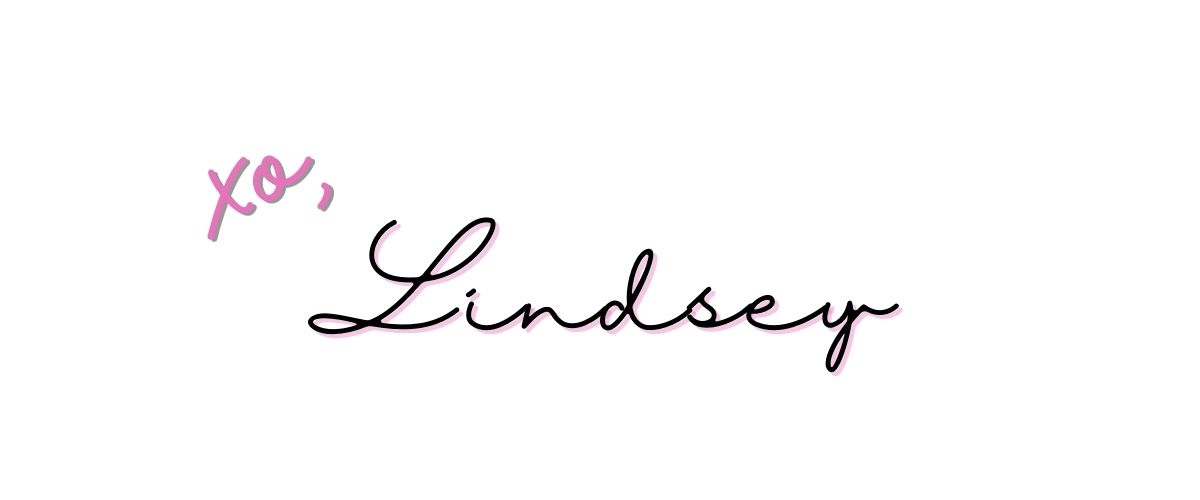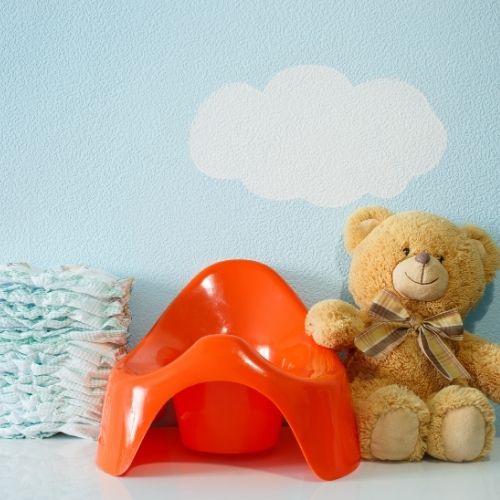Potty training is a big step in a toddler’s life! Within this post, you’ll find the signs your toddler is ready to potty train, the age you can start, how to encourage potty training readiness, as well as some tips for introducing the potty to your toddler!
Potty training is a big deal! And there is a wide spectrum of “normal” when it comes to what is acceptable potty training.
One of the biggest pieces of advice you’ll hear from experienced parents is, “don’t start potty training until your child is ready!”
But as a first time potty-training parent, you may be thinking, “but what does that even mean?!”
No worries! I’ve got you covered.
Before I potty trained my oldest, I did a ton of research. I wanted to know about every method and I wanted to pick the one that made the most sense to me. We did child-led potty training, and it was a breeze! You can read more about how I potty trained my 2 year old here.
You can definitely try to potty train before your child is ready, but from what I’ve heard it ends up leading to a lot more frustration, drama, and accidents than necessary. I’ve had friends try to force it, and ultimately the toddler won’t do it unless they’re ready. But when will that be?
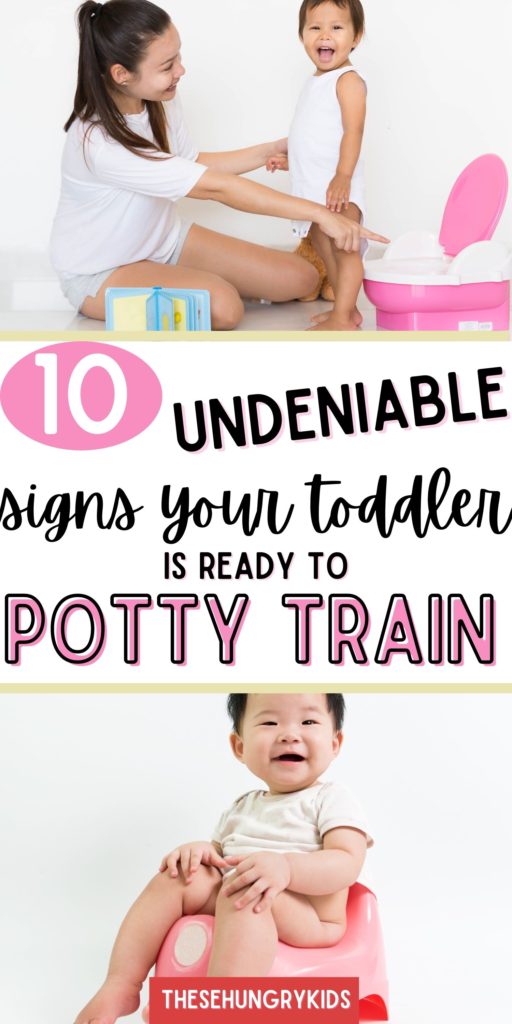
Disclaimer: I am not a doctor, and any concerns should be brought to your pediatrician’s attention! This post contains affiliate links for your convenience. This means if a purchase is made using the links on this post, I may earn a small commission at no additional cost to you.
What age can you start potty training?
According to this article on Healthline, most children are ready between 18 months and 3 years of age. The average age is about 27 months.
Generally speaking, children just aren’t ready before 18 months. And some kids aren’t ready until after they are 3 years old!
Every child develops at their own pace, so try not to compare your child to someone else’s. It’s totally normal for your child not to have any interest. One day it will click, and they will begin to show interest and be ready to try!
My experience potty training
Full disclosure: I am certainly no potty training expert! I’m just a mom that has done it, and did a ton of research beforehand to make sure I did it properly.
My oldest daughter potty trained just after her second birthday! She started showing signs of readiness around 18 months old, but wasn’t really ready yet. She had a hard time holding her bladder until she was about 2.
I followed the child-led potty training method. Basically, I put it entirely in my child’s control. You can read more about how I potty trained my daughter at 2 years old here.
My middle child is 22 months old. She showed zero interest in potty training until this past week. We just started introducing the potty and she doesn’t fully understand yet.
Her language is not as developed as my other child’s was, and while she will answer me if I ask if her diaper is soiled, she will not outright tell me that she has to go potty.
I’m not worried, she’ll do it when she’s ready! I put no pressure on her to use the potty, but I offer it to her and keep it available.
If there’s anything I’ve learned about potty training, it’s:
- Don’t make it scary
- Don’t make it a power struggle
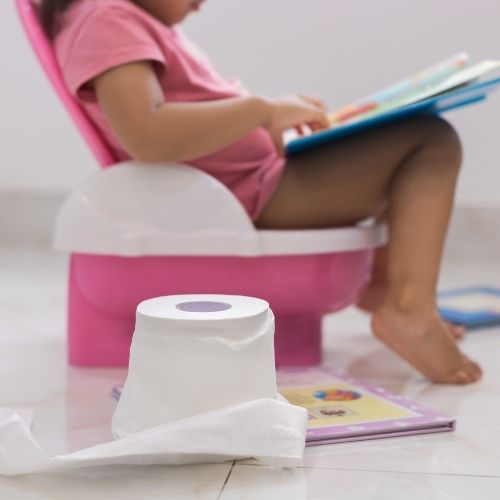
Signs your child is ready to potty train
Note: Your child may exhibit some, but not all of these signs.
- Your child can identify when they have to pee or poop
They may say “potty” or they may just show behavioral signs like crossing their legs and doing the nervous dance. What matters is that they can identify the feeling! - Your child tells you when they have soiled their diaper
If they find the diaper to be uncomfortable, that’s a good place to start! You can acknowledge the diaper is uncomfortable and suggest they use the potty so they don’t have to wear one. - You notice their diaper is dry for longer periods of time
Pay close attention to how often they go! Once they can hold it for an hour or more, you can start offering the potty. If they still have no control over their bladder and are going every 30 minutes, it’s not a good time to start potty training. - The child begins showing interest in the toilet
Maybe they want to watch you use the toilet, are fascinated with how it works, or have asked to use it themselves! An interest in the potty is a great indicator your toddler is ready to potty train. - The child may start showing interest in other people using the toilet
Did they notice someone left the room to use the toilet? Talk about it! It’s a great idea to make elimination seem normal to encourage readiness. - Your child may start talking about the potty
My daughters started by saying things like, “Mama use the potty” or “baby go potty.” I’d say, “yes, you’re right! You can use the potty, too.” - The child does not want to wear diapers anymore
This is the most annoying sign ever. My 22 month old is doing this now! She’s not quite ready to use the potty, but she doesn’t want to wear a diaper either. I just keep encouraging her to try to use the potty when she doesn’t want her diaper on, and I trust she’ll go when she’s ready. - Your child can tell you when they are going pee or poop
If your child can communicate their elimination needs, you can offer the potty at the right times. Give it a try! - There is a desire for independence
At some point, a flip switches in a toddler’s brain and they want to act like tiny adults. Encourage potty training as a natural step towards their independence! - The child has an interest in imitating adults, or copying others’ behavior
For toddlers that have an interest in imitating adults, make it very known when you are using the potty and offer them a chance to try. This is a great way to promote potty training in toddlers.
Most importantly, your child needs to be able to hold their bladder and bowels for an extended period of time, and must have good communication skills. They have to be able to tell you when they need to go so that you can get them to the potty in time!
If your child isn’t ready, no worries. Keep reading to learn how you can encourage your child to get ready for potty training and how to gently introduce the potty to your child.
How to encourage potty training readiness
As you may have learned by now, I truly believe you can’t potty train a child until they’re ready! Well, maybe you can, but it doesn’t seem worth the struggle to me.
Here are some ways you can encourage your child to develop potty training readiness!
Talk about using the toilet when you use the bathroom
It may seem a bit awkward, but remember, you aren’t talking to an adult! You are teaching your child through conversation how using the potty works.
I started by saying things like, “I’m going to the bathroom now because I have to pee! I don’t wear a diaper, so I need to sit on the toilet to go pee. See how that works? Now that I’m done, I’m going to wipe! After I wipe, I need to flush the toilet and wash my hands. Now I can go back to playing.”
This gives your child clear expectations of using the potty, as well. They will begin to learn the sequence of using the potty and will learn what to expect.
This is especially effective for only children or the oldest child. Younger children may already have observed potty time enough to know what to expect.
Talk about using the potty when you change your child’s diaper
Similar to the point above, have the same conversation when you are changing your child’s diaper.
The conversation may go something like this: “I see you went poop! I go poop on the potty. If you want to try pooping on the potty next time, tell me before you have to go and you can go on the potty, too! When we go poop on the potty, we can flush it down the toilet so that it doesn’t stick to our skin and make us stinky.”
Make elimination seem normal and acceptable
One of the biggest ways you can make it seem normal is by following the two points above!
Additionally, you can talk about how animals go potty, friends and family members, etc.
The goal is to make it seem less scary and unpredictable, and more of something that is natural.
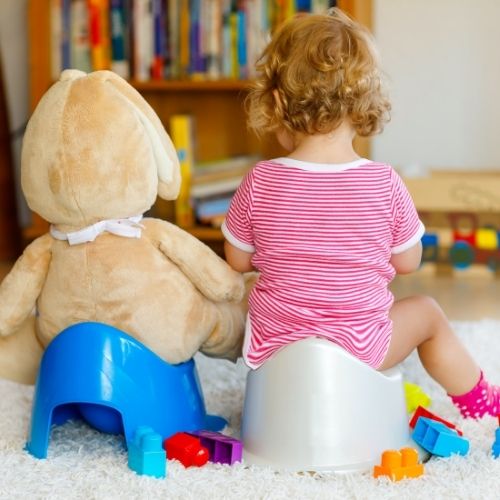
Read books about potty training
Reading books is a great way to reinforce potty training! Here are some of our favorite potty training books:
- A Potty For Me! By Karen Katz
We personally used this book. It’s a lift-the-flap book and discusses how you feel when you need to go and use the potty! - Dino Potty
The main character is a cute dinosaur. This rhyming book talks about exactly what to expect when going potty and the steps you take in the bathroom. - P is for Potty (Sesame Street)
Any other Elmo lovers out there? This life-the-flap book will interest your little Elmo-loving potty-trainer. - Daniel’s Potty Time (Daniel Tiger’s Neighborhood)
Daniel Tiger’s Neighborhood is one of our favorite children’s shows. This book follows along with the episode to make potty training easy.
Role play potty training with toys or dolls
This is a great way to eliminate fear of the potty! Once they see how easy it is, they may be more inclined to try themselves.
There are dolls that are specifically designed to use the potty (such as this one), or you can use your child’s favorite dolls or toy.
You can either have the toy use whatever potty your child is using, or get a potty training doll kit like this one.
Ways to introduce the potty to a toddler
If your child is showing signs they are ready to use the potty, it might be time to introduce it. This can go however you feel your child needs.
I found it very effective to start bringing my child to the bathroom with me, and encouraging her to try afterwards. This made it seem like a normal, routine thing that we do, and eliminated any fear of the unknown.
I also gave her a ton of choice in the matter! As I said above, I really tried to put my child in charge of her body. I let her pick the underwear she was going to wear, which toilet she’d use, and would give her a voice in whether or not she needed to go. If she said she didn’t want to use the potty, I’d suggest we try again in 5-10 minutes.
Other ways to introduce the potty:
- TV shows (Daniel Tiger has a good episode on using the potty!)
- Visiting the store to pick out underwear, a training potty, toilet paper, etc.
- Role play using the toilet
- Encouraging your child to sit and use the potty, even if they don’t pee or poop offer praise and encouragement
- Make up silly songs about the potty
Any other parents have any other advice to know when your child is ready to potty train?
Let me know in the comments below! Happy toilet training!
